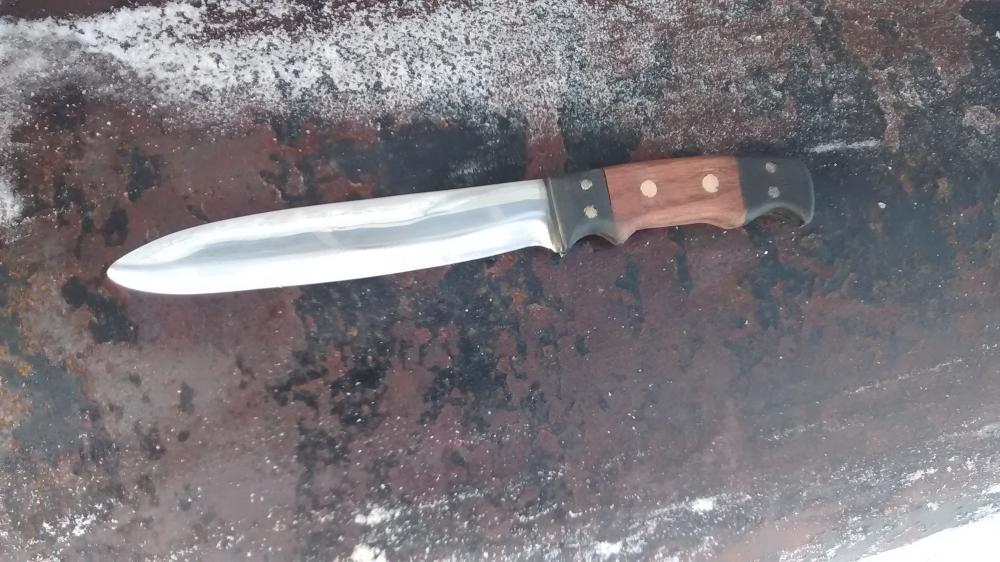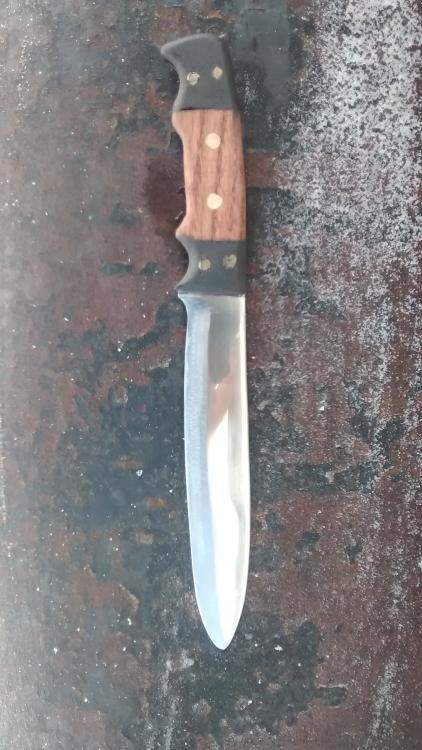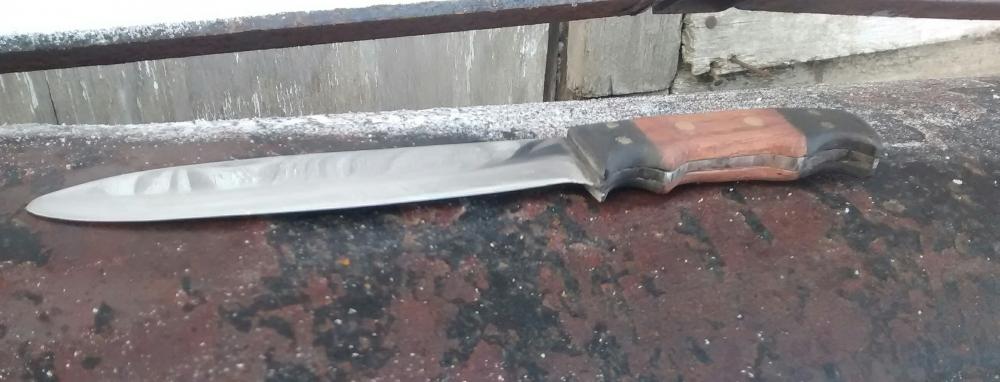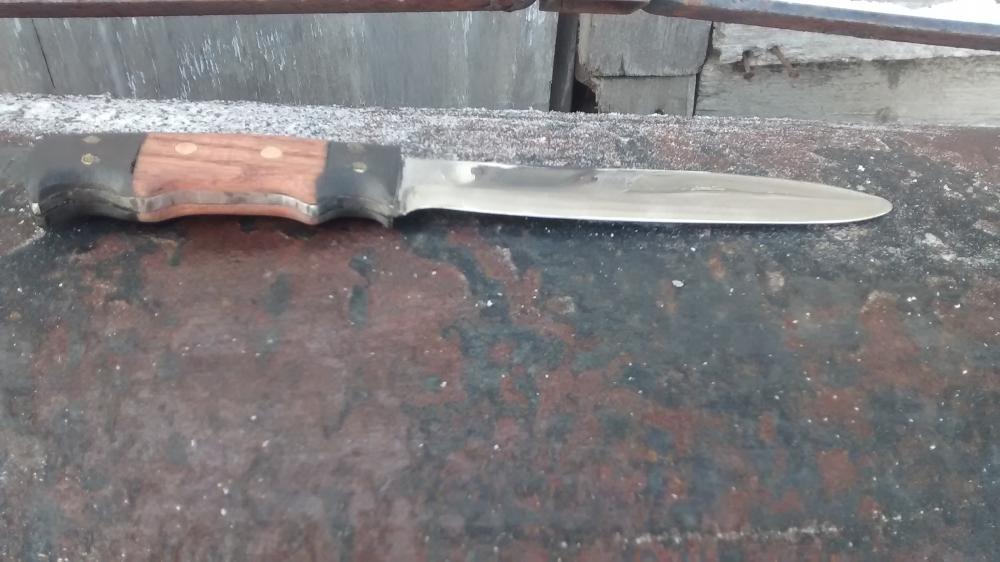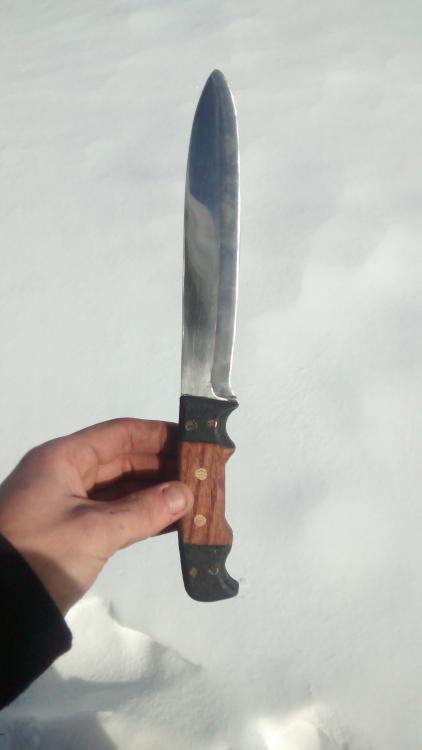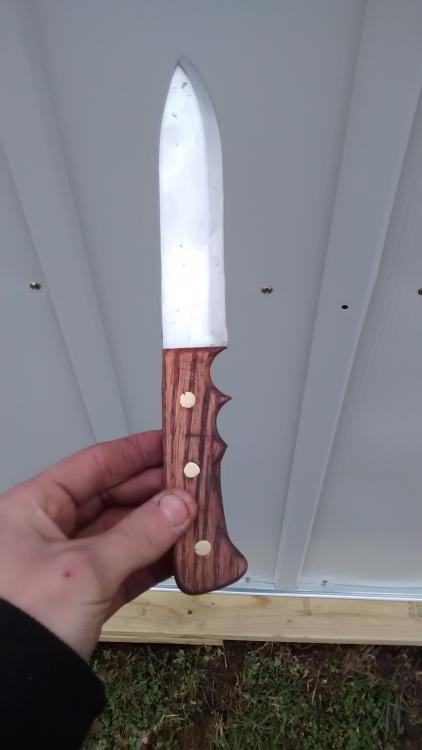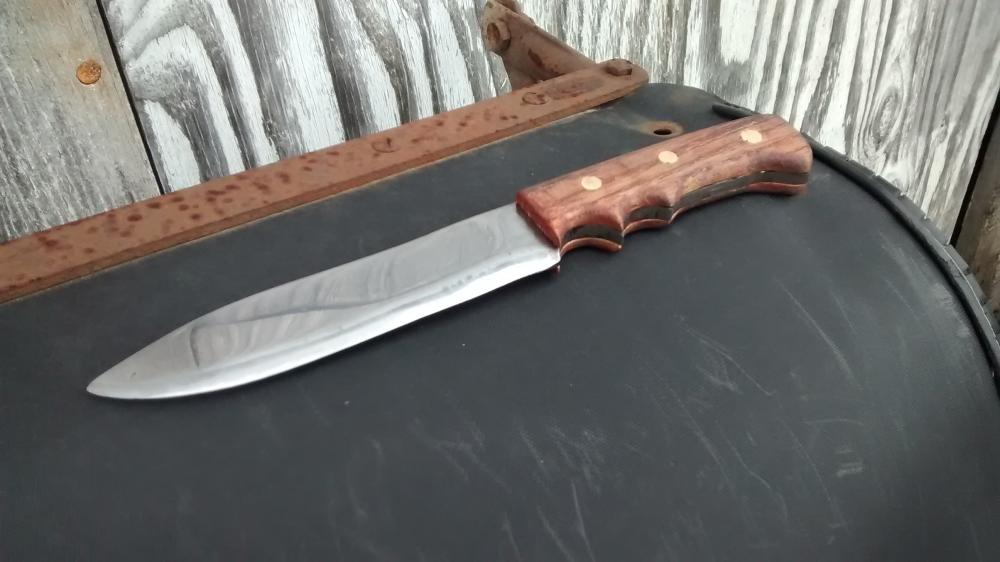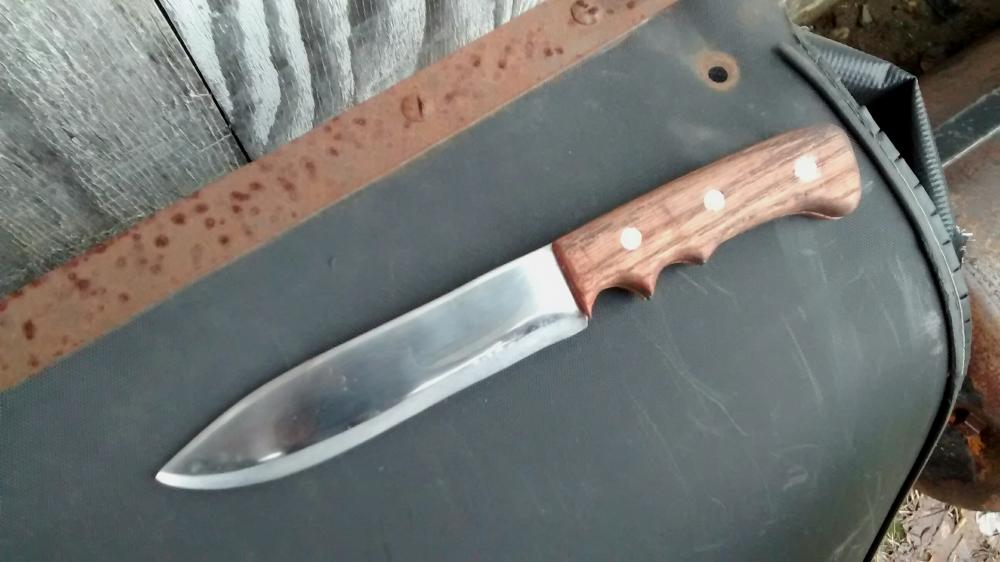-
Posts
733 -
Joined
-
Last visited
Content Type
Profiles
Forums
Articles
Gallery
Downloads
Events
Everything posted by Will W.
-

Looking for advice about selling knives
Will W. replied to Will W.'s topic in The Business Side of Blacksmithing
C-1ToolSteel I agree. It's unlikely, but I must concede his point. It is possible, and the liability could fall to you, though I have a hard time wrapping my head around that. If someone uses a truck to commit a crime, nobody pits the blame on Ford. I could totally be wrong about this though. That is mostly what I do though. A lot of hunting knives, camp knives, and Bowie's, though bowies always give me a little trouble, and the occasional axe. I would (try to) make anything a customer wants though, apart from swords. That won't happen haha. -

Looking for advice about selling knives
Will W. replied to Will W.'s topic in The Business Side of Blacksmithing
1776 Admittedly, I'm not incredibly skilled either. I love making them, and when this opportunity came up, it just got me thinking. But I've posted a few before on here, nothing compared to the collection I've actually made though haha. Notownkid That was worded poorly I suppose. I am confident in my work, but there is always a shimmer of doubt in the back of my head, it's just how I am. Are there any micro cracks in the steel? Maybe I could have made it just a little harder? Or put a better edge on it? As stated, I'm no pro, so I have a lot to learn yet, 100% confidence may be one of those things. A lot of what you stated, though, I honestly had not considered. Thank you for the response. -

Looking for advice about selling knives
Will W. replied to Will W.'s topic in The Business Side of Blacksmithing
Marc1 I agree. There are many skilled bladesmiths on this site alone. I also agree on the point about the gate, but there are few people in my area willing to pay that much for a hand made gate, though they are out there. There are, however, many hunters, fisherman, and general outdoorsman who I think may appreciate a hand made knife to carry around. That opportunity seems more practical to me, at least around my neck of the woods. BIGGUNDOCTOR All good points, thank you. I feel fairly confident in my work, I would never let it out of my shop if I was not. The price is the big thing that always gets me however. I often look at my knives after they're finished and wonder "how much would I pay for this, if I were the customer?" Its difficult, as the craftsman, to judge that. I see flaws, and things I wish I changed or did better, however minor they may be. -

Looking for advice about selling knives
Will W. posted a topic in The Business Side of Blacksmithing
Good day. This will be a long post. I was at the hardware store today, getting supplies, when a worker there asked me what I was cooking (I had several bags of charcoal) and I told him that I was a blacksmith and it was for my forge. We got talking about knives and what not, and he asked if I sell them, and that he would be interested in buying one. I told him that I haven't sold any yet, and it's just a hobby for me at this point in time. I told him I would bring a few next time I came so he could see my work and maybe we could talk it over. As I was checking out, I saw him chatting with his buddies across the store, who quickly turned and looked at me with grins on their faces. I assume he mentioned that I am a knife maker to them. This got me thinking though, if they were as interested as he was, and am I really ready to sell my work? I've been making knives and tools for about a year now (not long at all, I know) but i have made more than i can count off the top of my head, and I trust my blades. I test ALL of the knives I make (chopping, slicing, stabbing just about anything), and the majority of them hold up very well. I think I have a somewhat decent grasp of the craft, but I don't know if I'm ready to take somebody's money for them, even on a small scale. If I did, I would make every one as perfect as I possibly could, and i would sell them for what theyre worth, i wouldnt try to make a killing. I have made several knives as gifts, and the people ive given them to report back nothing but good news. I guess in the end, I'm just looking for some advice here. How did you guys get your start selling knives? How did you know you were ready? I realize these types of questions are all over the forum, and yes, i have read through them. Just wondering if some new input could be added. Too much information is (usually) never a bad thing. Thanks for reading. Will W -
I am no swordsmith (I'm barely a knife maker) but good grief, that looks absolutely beautiful. Truly outstanding work, thank you for sharing it!
-

Integral bowie with autumn leaves cast into the handle window
Will W. replied to TheoRockNazz's topic in Knife Making
Going off of the pages idea (forgive me if this is blasphemous) maybe you could print out quotes from the Bible and cast them in for someone who is religious? You may not want to rip pages out of a Bible, that's why I said print them haha. Then perhaps on the other side, a different quote, or the ashes idea that Thomas recommended? Just a thought. Great looking knife by the way, nice work. -
Looks cool. Nice work.
-
As stated, I would mainly just worry about your hand slipping forward during use. It could potentially injure the user. Just as a recommendation for the next one, maybe try grinding/forging/filing finger grooves in? If lined up properly, they make it feel great in the hand too. Just my two cents. Looks pretty good though, nice work.
-
Looks pretty nice. I like the handle, it looks like it wouod fit the hand well. You seem to have drawn the metal out very nicely, for the amount you had to work with. I realize it's just a shop knife, but why not take your grinder and sandpaper and clean up the flat section between the bevel and the spine? For what it's worth too, I find it useful to forge the blade out, and clean it all up, grind your bevels to finish, get it where you want it, then quench it in a separate fire. That way you don't need to worry about ruining the hardness with the grinding. And I usually forge out another knife, or whatever you have to make, in the same fire I used to quench the blade, so your not wasting the fuel just for a quench. That's just my process though. Looks like that blade will serve you well though.
-
BIGGUNDOCTOR: Thanks. I went down to 2000 grit sandpaper, so she is shiny haha. The bevel runs up to a little under half of the blade width. But i had not considered annealing them actually. Thanks for the tip, I'll try it in the future.
-
Good day, everyone. I finished this blade a little while ago. It's similar to the last knife I posted, but I wanted to challenge myself, so I did a three piece handle, and it definitely tested my patience and skill (while humbling both, I am still quite green.) It is flawed, but overall, I'm happy with how it turned out. The black sections are white walnut, and the red is oak. 3/16" pins for the oak and 1/8" for the walnut. The 1/8" pins, I learned, are quite tricky to peen, and they chipped a few times (not proud of them.) The blade itself is 5160, dual cycle tempered (after hardening of course) at 375° for ~an hour each cycle. 11" overall, and it has a slight recurve in it, which was intentional. It's hard, sharp, and fits in the hand well. The pictures are not fantastic, i apologize. Any thoughts, critiques, or recommendations are always welcome and much appreciated. Thanks in advance.
-

Having problems soldering guards
Will W. replied to Will W.'s topic in Knife making Class General Class Discussion
Actually no, I did not try that. Overlooked that little detail. I'll give that a try next time I'm in the shop. Thanks for the reply. -
First, I've been asking a lot of questions lately. Not trying to be annoying (and I hope I do not come off that way!) I just know that I have discovered something here that I love with a passion, and I truly appreciate the knowledge that is distributed here. Second, I have read everything I can get my hands on regarding soldering on guards. I would not ask without checking. Even after reading a lot of this info, I'm still having trouble with it. The blade I'm working on is a tanto, essentially, and I wanted to put a small guard on it. I've only ever done one guard before, and I MIG welded it, and i think it turned out awful, you could see the small spots of incomplete fusion, and the lines of the edges of the weld after grinding. So, I tried practice soldering a few pieces today. Just two pieces of mild (though the actual blade is 5160) with plumbers 95/5 solder, and the rosin flux typically used with it, propane torch as heat. I slotted the on piece to fit around d the other, simulating a guard. The fit was pretty tight. The actual soldering went great, but there was no structure. I could tap it with a hammer, and it broke right off immediately (after it cooled, or course.) I applied the heat from the underside, like where the tang would be, and used just enough heat to get it done. Any idea why it was so weak? Was it the solder I used possibly? Is there a better solder to use for the situation? Thanks in advance.
-
OK. I understand what you mean. Seems there is no simplistic answer, as is almost always the case. I'll give the vinegar and salt thing a try if I ever make a successful pattern welded blade. Thanks for the input.
-
SLAG, I considered using a base like lye to neutralize as well, but I figured that would cause a more violent reaction, like you describe. I've always been told that there's an abundance of limestone in my area, and I've tried to find it before and test it, with little luck. I think I would just use baking soda, as I would not be neutralizing very often, cost is not a huge deal. I've considered using muriatic acid and ferric chloride though. If I spend the time to make a pattern welded blade, I would want to make it look nice at the end, so from what you say Thomas, vinegar just is not worth it. Ferric chloride comes in a powdered form, and must be pre-mixed to etch, right? How do you safely store the solution once mixed? In closed glass containers I assume?
-
I tried searching the forum for info on using vinegar, and i couldnt find much. But I know that adding baking soda to most acids neutralizes it. The way i understand it, it lowers the ph to the point where its no longer very acidic. But for obvious reasons, you can't dump it down the drain or anything like that, so the only way I know to get rid of it is have it disposed of by a hazmat team. No doubt, I could be wrong about this, my knowledge is rather limited on the subject. That's interesting about the hot vinegar and salt though. I may try that in the future.
-
I've read that to bring out the pattern in Damascus, you need to etch it in acid. I know a fair deal about chemistry and acids, and I am weary about working with them (for obvious reasons) but I do want to do pattern welded knives, eventually. I have de-galvanized steel before using vinegar (weak acetic acid), it takes a while but vinegar is far more safe than more potent acids. I realize that zinc is pretty reactive, so even a weak acid can strip it, but is it possible to etch with vinegar? Would I perhaps have to concentrate it? Also, any general information regarding storage and disposal of acids would be very appreciated, I have very little actual experience with them. The only way I know to dispose of it is to neutralize it and call a hazmat team. Thanks in advance.
-
They were just butted on top of each other. I hadn't even considered the possibility that a large inclusion formed in the center. Now that you mention it, it seems likely. The outer edges probably welded up, and then broke when i applied the pressure of shaping it. Thanks for writing that. Perhaps i need to think these plans through a little more haha. I ended up just taking some tool steel and upsetting it to fit the hardie, so in the end, problem solved.
-
Thanks for the input guys. If I go for another knife similar to this design, I will heed the warning. A little more rounded may actually look pretty good. May feel better in the hand as well. I had no idea that was called a Scandinavian grind though. There is a term for just about everything it seems haha. Speaking of micarta though, where can you actually buy the stuff? Besides online of course. I like to tangibly hold the item before I buy it, I am very weary of buying almost anything online. I have looked for it almost everywhere I could think to.
-
Frosty, I would have figured the oil would inhibit the flux. Good to know that it helps. I may try that in the future. I agree completely. The nice gold, blues, and purples you can get is just remarkable. When I was learning how to tig weld stainless though, I can't tell you how many of my welds just came out black haha. Most of what I did was 4140 though. Basic stuff. I've done some 440A (I think that's what is was) on kitchen equipment, and some 316 (again, I am pretty sure) in pipe welding. Numerous welds on unknown alloys as well. I've welded some chrom-moly as well, on race car frames, and in my experience, that stuff will never cooperate haha.
-
Yeah, I see exactly what you mean. During the sanding of the handle, I actually chipped pieces off of those points a few times. I suppose I should have taken the hint. I wanted to make it look sharp and neat, but function trumps form. I appreciate the criticism. Thank you.
-
Here are a few more images. They are still kind of fuzzy, and overall my camera still sucks, but I hope it helps. JHCC and Latticino, I've seen work from both of you, and I do consider you guys truly skilled. I hope my work may reach half the quality of your own. Thank you for taking the time to reply Latticino, I appreciate the recommendations. I did get a little carried away with the grinder near the ricasso and plunge line, so it kind of killed the crisp lines it could have had. My secondary bevel is short. Almost non existent. Again, too grinder happy towards the finish. I need to learn to slow down I guess. The heat treatment went very well though. I work with this steel a lot so I think I have the treatment down, but it is an unknown alloy, so I'm playing a guessing game.
-
I can try to get a few good ones when I get home. I apologize, I only have the camera on my cell phone to work with and it is terrible, honestly.
-
Unfortunately, I have learned that lesson the hard way numerous times, as many definitely have, and I am bound to do it a whole lot more. If anything, you figure out how something does not work. Haha.

